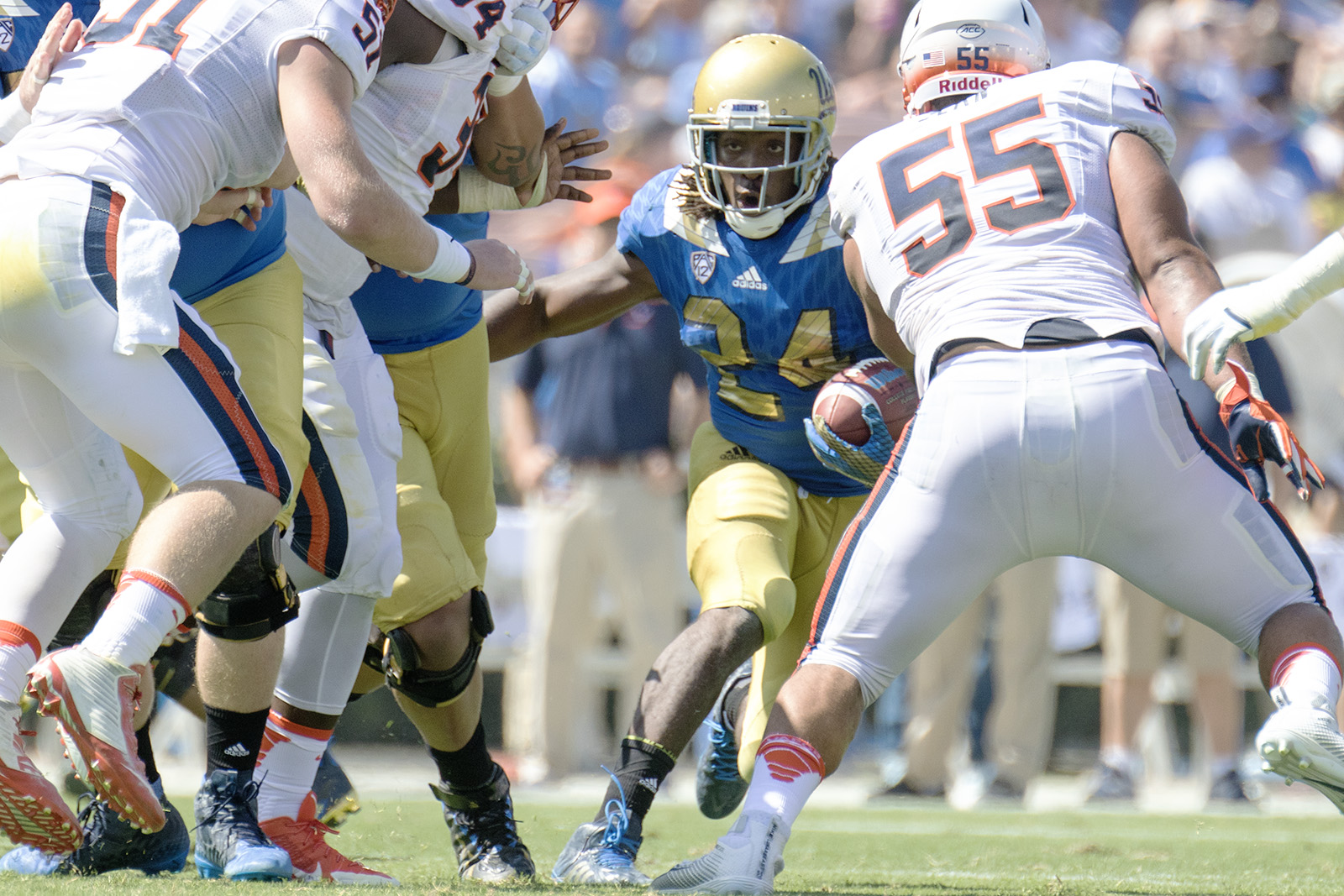Football’s lack of production on first down puts team in hole vs. ASU

Redshirt junior running back Paul Perkins and the UCLA offense lacked efficiency on first downs in their loss to Arizona State – a trend that has been plaguing the Bruins as of late. (Austin Yu/Daily Bruin senior staff)

By Matt Joye
Oct. 8, 2015 4:21 a.m.
UCLA’s struggles on third down were well-documented against Arizona State.
The Bruins went three for 14 on third down, and went three-and-out on eight of their 17 offensive drives. Two of those three-and-outs resulted in safeties.
“If you go three-for-14 on third downs, it’s hard to win football games,” said offensive coordinator Noel Mazzone.
What Mazzone didn’t talk about was UCLA’s lack of efficiency on first down, which may have been even more fatal to the No. 20 Bruins (4-1, 1-1 Pac-12).
According to the football analytics website Football Outsiders, first down efficiency is one of the measures of an offense’s success rate. A first down play is considered “efficient” when a team picks up half of the needed yards. So if UCLA has a first-and-10 play and gains five yards, the play is marked down as “efficient.”
The problem for the Bruins recently has been their inability to meet that standard of efficiency very often.
In the loss to Arizona State on Saturday, UCLA had just 13 efficient first-down plays on 31 attempts. And against Arizona two weeks ago, UCLA tallied only nine on 31 first down plays.
While the Bruins still scored 56 points against the Wildcats, they were gifted with some ideal field position that they will likely not receive very often as the season goes on. The Arizona State game proved that.
Take UCLA’s first four offensive drives against Arizona State as examples of how important first-down plays can be. The Bruins started each of those drives with inefficient first down plays in their own territory, setting up freshman quarterback Josh Rosen with four straight third-and-longs to start the game.
That didn’t end well, as UCLA went three-and-out on all four of those drives, with the fourth one resulting in a safety. By the time the Bruins got to their fifth offensive drive, they were already in a 9-0 hole on the scoreboard.
Diagnosing the problem
Over the past three games, a pattern has appeared to develop in Mazzone’s play calling on first down.
In each of those games, Mazzone has started his first four drives the same way: with a run to redshirt junior halfback Paul Perkins.
It worked against BYU – to the tune of 175 rushing yards on 20 first-down rushes – but teams have started to catch on to the strategy, putting more players in the box on the early downs.
“(Arizona State) really committed a whole lot of guys to the run,” said coach Jim Mora. “More so than the other four teams we’ve played before them – in terms of really stacking the box, really bringing guys off the edge, and slanting and moving.”
With Arizona State stacking the line of scrimmage, UCLA averaged just 2.7 yards on its 15 first-down rushes. Mazzone said he forced the issue a bit with the run early on, but added that he still believes strongly in his run game.
“You know how those things work: If you run it the first four first downs and don’t make anything it’s shitty, and if you throw it the first four first downs, (the question is) ‘Why didn’t you run it’?” Mazzone said. “We’re a team that has a ton of confidence in our offensive line and Paul. And we play good when we get our running game going.”
But against Arizona State, UCLA actually did better when it used its pass game to set up its rushing attack.
Finding the solution
With teams stacking the line of scrimmage against UCLA, the passing game has become the team’s best source of offense on first down. Since the start of Pac-12 play, the stats speak for themselves: UCLA has averaged 6.0 yards on first down passes, compared to 3.1 yards on first down rushes.
In the Arizona State game, there were moments when the Bruins’ passing game actually opened things up for the running game. Perkins’ longest rush of the game came after UCLA opened up its 15th drive with two consecutive first down passes of 18 and 19 yards, respectively.
Moving forward, it will be interesting to see if Mazzone sticks to his run-first strategy or if he allows freshman quarterback Josh Rosen to go deep on first down – just like he did on the first play of the season against Virginia. After all, Rosen does like to get started quickly.
“I just wanted to touch the ball once and get rolling,” Rosen said after the Virginia game. “I get nervous.”




